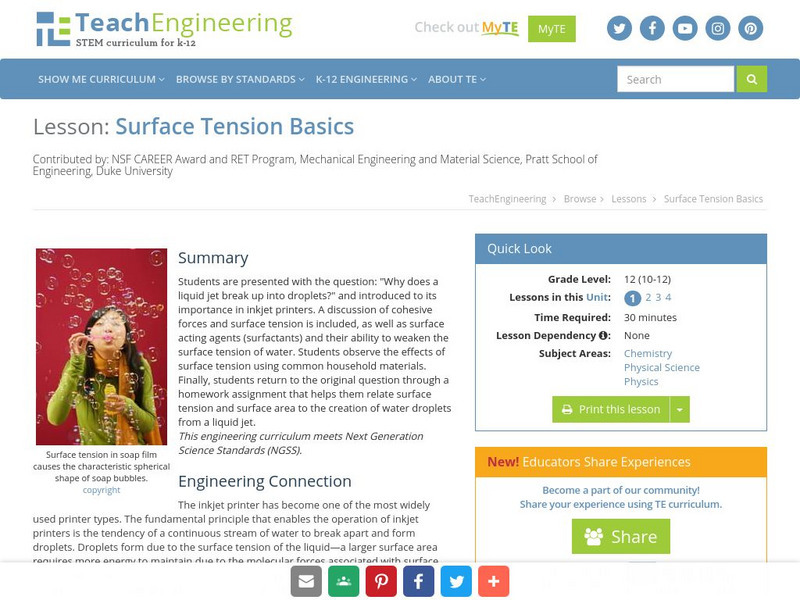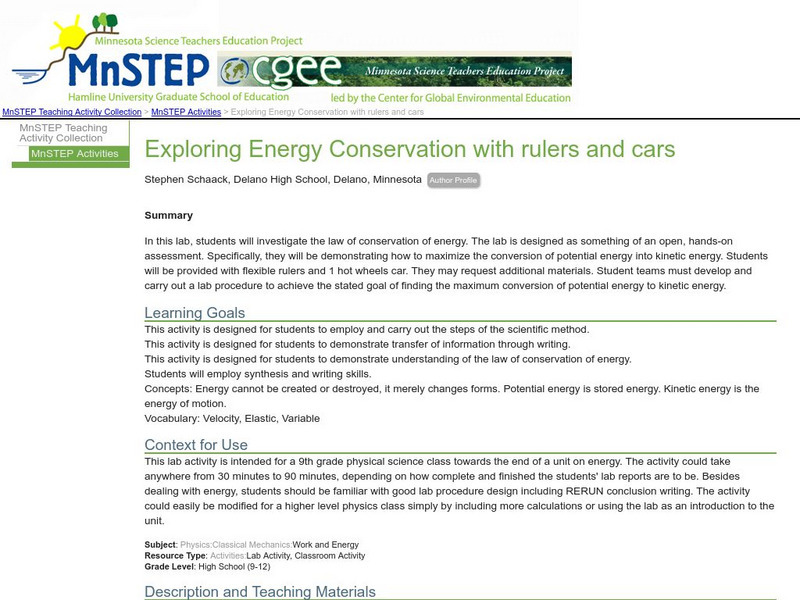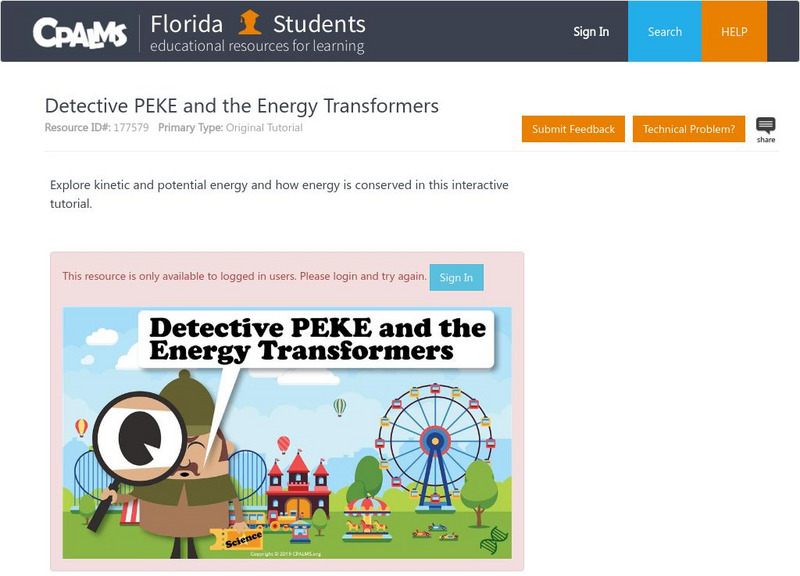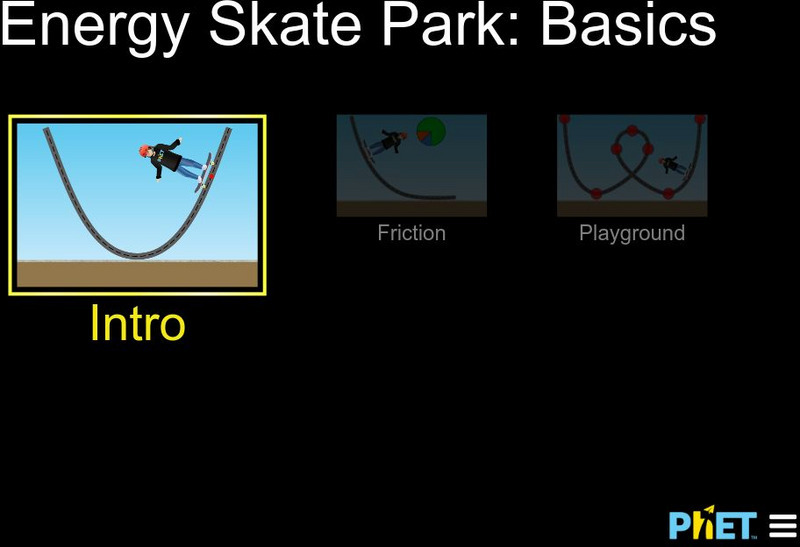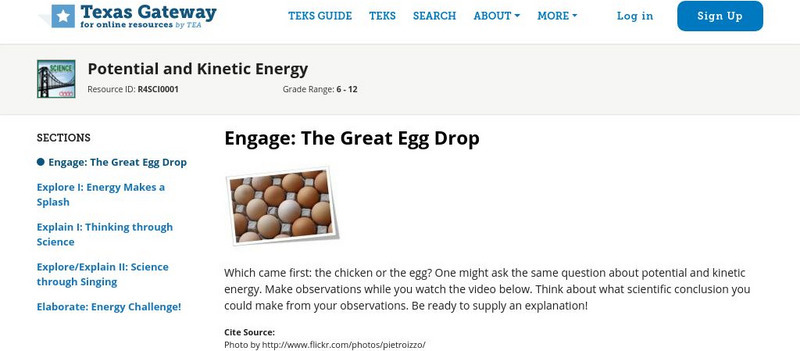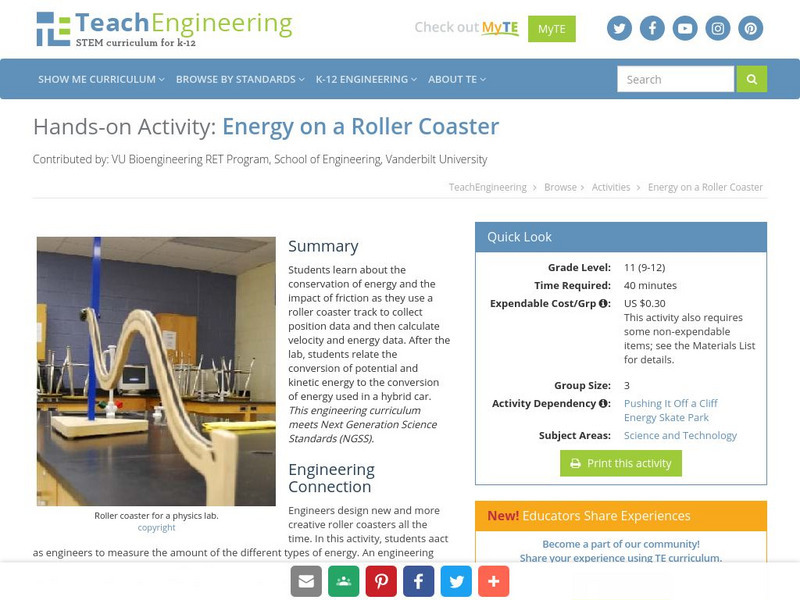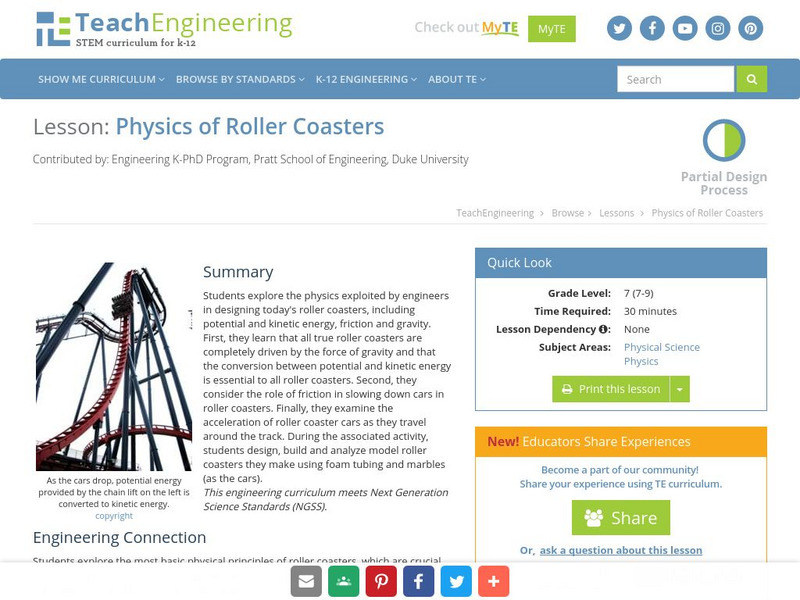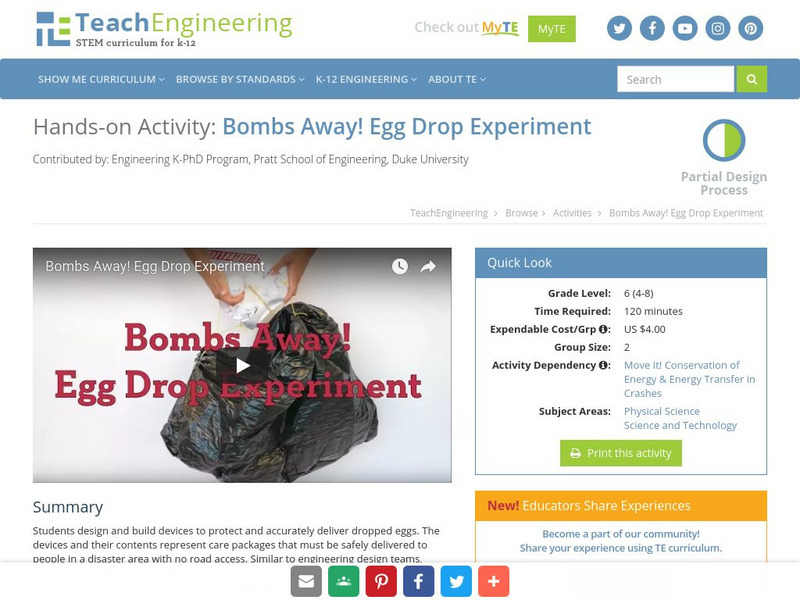Hi, what do you want to do?
TeachEngineering
Teach Engineering: Surface Tension Basics
Students are presented with the question: "Why does a liquid jet break up into droplets?" and introduced to its importance in inkjet printers. A discussion of cohesive forces and surface tension is included, as well as surface acting...
FT Exploring
Ft Exploring: Energy Conversions: Potential to Kinetic Energy
Find out how gravitational potential energy is converted to kinetic energy, then finally into low-grade thermal energy.
CK-12 Foundation
Ck 12: Physics: Energy Study Guide
Understand and review energy concepts with this study guide.
Concord Consortium
Concord Consortium: Energy of a Pendulum
In this interactive, drag a pendulum to set its initial height and observe how height is related to potential energy. Then release the pendulum and observe the change from potential energy to kinetic energy, and ultimately to thermal...
Science Education Resource Center at Carleton College
Serc: Exploring Energy Conservation With Rulers and Cars
In this lab, students will investigate the law of conservation of energy. The lab is designed as something of an open, hands-on assessment where students demonstrate how to maximize the conversion of potential energy into kinetic energy.
Physics Aviary
Physics Aviary: Energy Transformations
This lab is designed to have students investigate the transformations that occur when elastic potential energy is converted to kinetic energy. Students will be able to modify the mass of the object, the spring constant of the spring and...
Physics Classroom
The Physics Classroom: What Is an Electric Circuit?
In this tutorial the concept of electric potential difference is discussed. Electric potential is the amount of electric potential energy per unit of charge that would be possessed by a charged object if placed within an electric field...
Better Lesson
Better Lesson: Drop and Pop Energy and Speed Exploration
Fourth graders use a toy to make observations that speed is related to the amount of energy in an object as well as work with gravitational and elastic potential energy.
CPALMS
Florida State University Cpalms: Florida Students: Detective Peke and the Energy Transformers
Explore kinetic and potential energy and how energy is conserved in this interactive tutorial.
Texas Instruments
Texas Instruments: Conserving Energy
In this activity, students will find both the kinetic and potential energies as the cart rolls down the ramp. They will find the sum of the two energies, and show that this value is constant at all times.
Alabama Learning Exchange
Alex: Actions at Plate Boundaries
This lesson will allow the students to understand the cause and effects of plates interactions. The students will learn that plate boundaries function as a release for much of the Earth's potential energy. The students will be able to...
Concord Consortium
Concord Consortium: Protein Folding
Generate all polar, all nonpolar, or random proteins and observe how the protein folds in response to these molecular properties. Explore how the potential energy of the system changes over time to draw conclusions about how proteins...
Concord Consortium
Concord Consortium: Polar and Nonpolar Interface
Observe how molecules with hydrophilic and hydrophobic regions move in a mixture of oil and water, and pay attention to changes in potential energy over time. Move and rotate the molecules to see how they interact with their surrounding...
Concord Consortium
Concord Consortium: Oil and Water
Mix polar and nonpolar molecules together and observe changes in potential energy.
University of Colorado
University of Colorado: Ph Et Interactive Simulations: Energy Skate Park
Explore kinetic, potential, and thermal energy as you send a skateboarder along several pre-built tracks, then design your own. Charts and graphs show the distribution of the different forms of energy, illustrating how the total energy...
eSchool Today
E School Today: Energy
Explains different kinds of energy, covering kinetic, potential, gravitational, mechanical, sound, thermal, chemical, electrical, and radiant energy. Also looks at storage, transfer, and dissipation of energy. Includes a short...
OpenStax
Open Stax: Conservation of Energy
In the following tutorial, students will learn about the law of conservation of energy. They will read about some of the many forms of energy. They will understand the definition of efficiency of an energy conversion process as the...
Texas Education Agency
Texas Gateway: The Great Egg Drop!
Which came first: the chicken or the egg? One might ask the same question about potential and kinetic energy. Make observations while you watch the video below. Think about what scientific conclusion you could make from your...
Carnegie Mellon University
Chem Collective: Chemical Potential: Staircase Demonstration
As we look for connection points across disciplines, we are increasingly drawn to chemical potential as the connection point. This simulation shows particles thermally distributed on a staircase. A linear increase in energy leads to an...
Simon Fraser University
Chem1 Virtual Textbook: Energy, Heat, and Temperature
As part of a larger resource called "Getting started in Chemistry," this page examines various topics related to energy. The types of energy discussed include kinetic, potential, thermal, and chemical.
TeachEngineering
Teach Engineering: Energy on a Roller Coaster
This activity utilizes hands-on learning with the conservation of energy and the interaction of friction. Students use a roller coaster track and collect position data. The students then calculate velocity, and energy data. After the...
TeachEngineering
Teach Engineering: Physics of Roller Coasters
Students explore the physics utilized by engineers in designing today's roller coasters, including potential and kinetic energy, friction, and gravity. First, students learn that all true roller coasters are completely driven by the...
TeachEngineering
Teach Engineering: Bombs Away!
In this hands-on activity students learn create a device to protect a dropped egg and deliver it close to a target. Students learn about engineering as well as potential and kinetic energy and energy transfer
CK-12 Foundation
Ck 12 Exploration Series: Simulations: Physics: Trampoline
[Free Registration/Login Required] A module to help students understand that as a boy jumps on a trampoline energy is transferred from potential to kinetic energy.
Other popular searches
- Kinetic and Potential Energy
- Potential Energy Diagram
- Gravitational Potential Energy
- Kinetic Potential Energy
- Elastic Potential Energy
- Calculating Potential Energy
- Physics Potential Energy
- Potential Energy Pendulum
- Kinetic vs. Potential Energy
- Forms of Potential Energy
- Potential Energy and Water
- Kinetic vs Potential Energy





